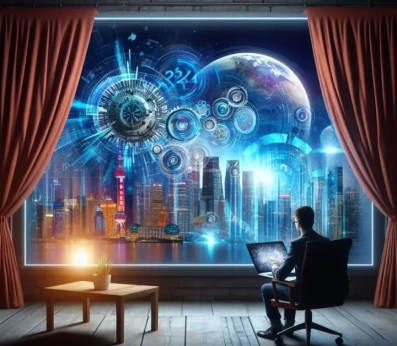Television once hailed as the epitome of entertainment and information dissemination, has traversed a remarkable journey of evolution.
In the digital era, where technology reigns supreme, the medium’s prominence remains steadfast, albeit with a modern twist
Super Bowl LVIII became the most-watched TV broadcast since the moon landing.
YouTube’s emergence as a dominant force in the media landscape has revolutionized how businesses engage with audiences. Through the power of video content, companies can connect with prospects, clients, and customers on a deeper level, sharing their brand stories, values, and offerings in an authentic and impactful manner. Corporate storytelling on platforms like YouTube not only humanizes brands but also fosters trust, loyalty, and emotional connection among viewers.
In this dynamic environment, businesses must recognize the importance of adapting their storytelling strategies to suit the preferences and behaviors of different generational cohorts. While older demographics may still gravitate towards traditional television formats, younger audiences increasingly consume content on digital platforms, seeking personalized and immersive experiences.
By embracing the power of storytelling across various mediums, businesses can effectively navigate the evolving landscape of television and business TV. Whether through captivating commercials, engaging web series, or insightful documentaries, the ability to convey narratives that resonate with audiences will remain central to success in the digital age.
In this article, we delve into the captivating evolution of television, highlighting its enduring relevance and the pivotal role of storytelling in today’s communication landscape.
The Ever-Popular Television
Television’s enduring popularity as a trusted source of news and information is deeply rooted in its long-standing reputation for reliability and credibility. In an era marked by the proliferation of digital media platforms and the rise of social media, television stands out as a beacon of trust and believability, particularly in times of crisis.
First and foremost, television’s credibility stems from its adherence to journalistic standards and practices. Established news organizations and networks invest significant resources in fact-checking, verification, and investigative reporting, ensuring that the information presented to viewers is accurate, impartial, and trustworthy. From seasoned journalists to expert analysts, television news programs feature experienced professionals who lend credibility to the stories they cover, instilling confidence in the audience’s minds.
Moreover, the visual and auditory nature of television enhances its credibility as a news source. By combining live footage, interviews, and on-the-ground reporting, television provides viewers with a multi-dimensional understanding of complex events and issues. Seeing and hearing firsthand accounts and eyewitness testimonies can evoke a stronger emotional response and foster a deeper sense of connection and empathy among viewers, reinforcing the credibility of the information presented.
In times of crisis, television becomes an indispensable lifeline for people seeking reliable information and updates. Whether it’s natural disasters, political upheavals, or public health emergencies, television news broadcasts serve as a primary source for breaking news, expert analysis, and critical updates. During these turbulent times, viewers turn to television for real-time information they can trust, helping them make informed decisions and stay safe in the face of uncertainty.
Furthermore, the legacy and reputation of established news programs and networks contribute to television’s trustworthiness as a news source. Programs like “60 Minutes,” “BBC News,” and “PBS NewsHour” have built a reputation for excellence in journalism over decades of dedicated reporting. Viewers have come to rely on these trusted brands as sources of credible, in-depth news coverage, cementing television’s status as the go-to medium for staying informed and educated.
Generational Shifts in Viewing Habits
You know, it’s fascinating how our viewing habits have evolved over the years. While television still holds its charm, the way we tune in has undergone quite the makeover, thanks to a mix of generational quirks and technological marvels.
Just take a look around – we’re spoilt for choice with streaming services, on-demand goodies, and the convenience of catching our favorite shows on our phones. It’s like we’ve got a buffet of entertainment options tailored to every taste and schedule. And who can blame us for indulging? Millennials and Gen Zers are all about that digital life, craving content that speaks directly to them, whenever and wherever they want it.
But hey, let’s not forget about the OGs of television – our beloved older generations. They’re the ones who still swear by the good old tradition of flipping through channels and catching the latest sitcoms or news broadcasts at the same time every evening. For them, there’s a comfort in the routine, a sense of familiarity that can’t be replaced by fancy streaming gadgets.
So, you see, it’s not just about what’s on the screen anymore. It’s about how we interact with it, how it fits into our lives, and how it reflects our generational quirks. Whether you’re scrolling through your favorite series on your phone or cozying up to your weekly dose of primetime drama on the TV, one thing’s for sure – television has never been more versatile, catering to every age, taste, and tech preference out there.
The Power of Storytelling for Corporate Video
Let’s talk about the power of storytelling in the realm of corporate video. In this fast-paced digital age, where attention spans are shorter than ever and the online world is overflowing with content, storytelling has emerged as the ultimate secret weapon for effective communication.
Think about it – in a sea of information overload, what captures your attention and leaves a lasting impression? It’s not just facts and figures; it’s the stories that resonate with you on a deeper level. Stories have this incredible ability to cut through the noise, touch our emotions, and make us sit up and take notice.
And when it comes to corporate videos, storytelling becomes even more crucial. Gone are the days of dry, boring presentations filled with jargon and statistics. Today’s audiences crave authenticity, connection, and meaning. They want to know the story behind the brand, the people behind the products, and the values that drive the company forward.
Embracing the YouTube Frontier
Enter YouTube the ultimate storytelling platform of the digital age. With its massive reach and diverse audience demographics, YouTube offers an unparalleled opportunity for corporate storytellers to weave their narratives and forge meaningful connections with viewers. Whether it’s through heartfelt testimonials, behind-the-scenes glimpses, or inspiring success stories, corporate videos on YouTube have the power to engage, inspire, and leave a lasting impression.
But here’s the thing storytelling isn’t just about entertaining or captivating an audience. It’s about building trust, fostering loyalty, and creating a genuine connection with your viewers. When done right, corporate storytelling on YouTube can humanize your brand, showcase your values, and differentiate you from the competition.
In today’s digital age, storytelling has become the linchpin of effective communication, transcending traditional mediums and finding resonance in the vast expanse of cyberspace. Whether you’re a startup aiming to make a splash, a seasoned company looking to rebrand, or a small business hoping to expand your reach, don’t underestimate the power of storytelling in your corporate videos.
YouTube, with its expansive reach and diverse audience demographics, emerges as a formidable platform for storytellers to weave their narratives and connect with viewers on a profound level. For businesses and content creators alike, establishing a presence on YouTube is no longer a luxury but a necessity in today’s digital ecosystem.
By embracing the art of storytelling and harnessing the potential of YouTube, brands can showcase products, share expertise, and forge meaningful connections with audiences across the globe. Beyond mere marketing tactics, storytelling allows businesses to cultivate authentic relationships with consumers, fostering loyalty and advocacy in the process. So, dive into the world of corporate storytelling on YouTube and watch as your audience engages, connects, and grows along with your brand.
Conclusion
As we reflect on the evolution of television and its enduring relevance in the digital age, one thing becomes abundantly clear storytelling reigns supreme as the cornerstone of effective communication. Across generational spaces and digital platforms, the art of crafting compelling narratives transcends boundaries, fostering connection, understanding, and empathy in an increasingly fragmented world.
In embracing the YouTube frontier, businesses and content creators have the opportunity to harness the transformative power of storytelling, shaping perceptions, driving engagement, and ultimately, leaving an indelible mark on the ever-evolving landscape of communication.



